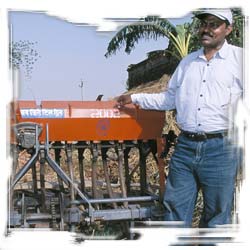February, 2005
 This is the story of Anil Singh, a farmer from the remote, relatively poor area of Uttar Pradesh, India, who found fortune with help from CIMMYT-South Asia Regional Program and the Rice Wheat Consortium for the Indo-Gangetic Plains (RWC). His eye-catching success has been based on reduced tillage and direct seeding of wheat.
This is the story of Anil Singh, a farmer from the remote, relatively poor area of Uttar Pradesh, India, who found fortune with help from CIMMYT-South Asia Regional Program and the Rice Wheat Consortium for the Indo-Gangetic Plains (RWC). His eye-catching success has been based on reduced tillage and direct seeding of wheat.
Arun Joshi, researcher at Banaras Hindu University and CIMMYT-South Asia/RWC partner, smiles when he tells the story of farmer Anil Singh, from Karhat Village in Mirzapur District. Singh was the first in the village to try zero-tillage for sowing wheat when it was introduced in 1997. “When Anil’s father-in-law first saw Karhat, he began telling everyone that women shouldn’t marry its men, because they wouldn’t be able to support a family,” says Joshi. “When Anil had success with zero-tillage and other farmers adopted the practice, his father-in-law changed his tune completely, and now says that all young ladies should marry men from Karhat!”
Singh, his brother, and the 11 other family members formerly scraped by growing only a rice-wheat rotation on some six hectares of land. Adoption of direct seeding without tillage for wheat has increased harvests and brought savings in seed, labor, diesel, farm equipment, and irrigation water. The practice allows earlier sowing of wheat, so the brothers have introduced okra, tomato, gourd, potato, mungbean, and other crops, and are growing “green-manure” legumes to enrich the soil. Through a participatory varietal selection program, supported by DFID-UK and coordinated by Joshi with CIMMYT input, farmers in the village have gained access to the latest, high-yielding wheat varieties. Singh used the added income from all of the above to sink a new well, put an upper story on his home, purchase a used car, and launch a rice and wheat seed company.
“Previously we had no linkages with agencies or persons to obtain knowledge or information,” he says. “We used to grow only the old varieties—we sowed the same seed for ten years! Now we are looking to diversify and intensify farming to get more cash.” Singh says that farmers come from far and wide on tractor trolleys, bikes, motorcycles, and other transport to purchase his company’s seed. “This is because they trust us and because we were the first in the region to sell seed. I want to make our company big, involve several villages, with each growing only a single variety to maintain purity and include many farmers.”
The village had no telephone or refrigerator when Joshi and his associates first came, and now it has plenty of both. According to Joshi, the credit for farmers’ improved fortunes goes to the Directorate of Wheat Research of the Indian Council of Agricultural Research, Karnal, the RWC, the Centre for Arid Zone Studies-UK, and CIMMYT-South Asia. “It was the idea of CIMMYT regional wheat breeder Guillermo Ortiz-Ferrara to test varieties and zero-tillage with farmers, and we joined hands,” he says.
The RWC does much more than simply promote direct seeding for wheat crops. To learn more about the Consortium, its partners, and its supporters, read the recently published report RWC Highlights 2005 (in PDF version 88kb).
The RWC includes the national agricultural research systems of Bangladesh, India, Nepal and Pakistan, as well as international centers like CIMMYT and advanced research institutes. It promotes resource-conserving practices and more diverse cropping in the rice-wheat farming systems that cover 13.5 million hectares in the region, and provides food and livelihoods for over 300 million people.
 Innovations
Innovations 
